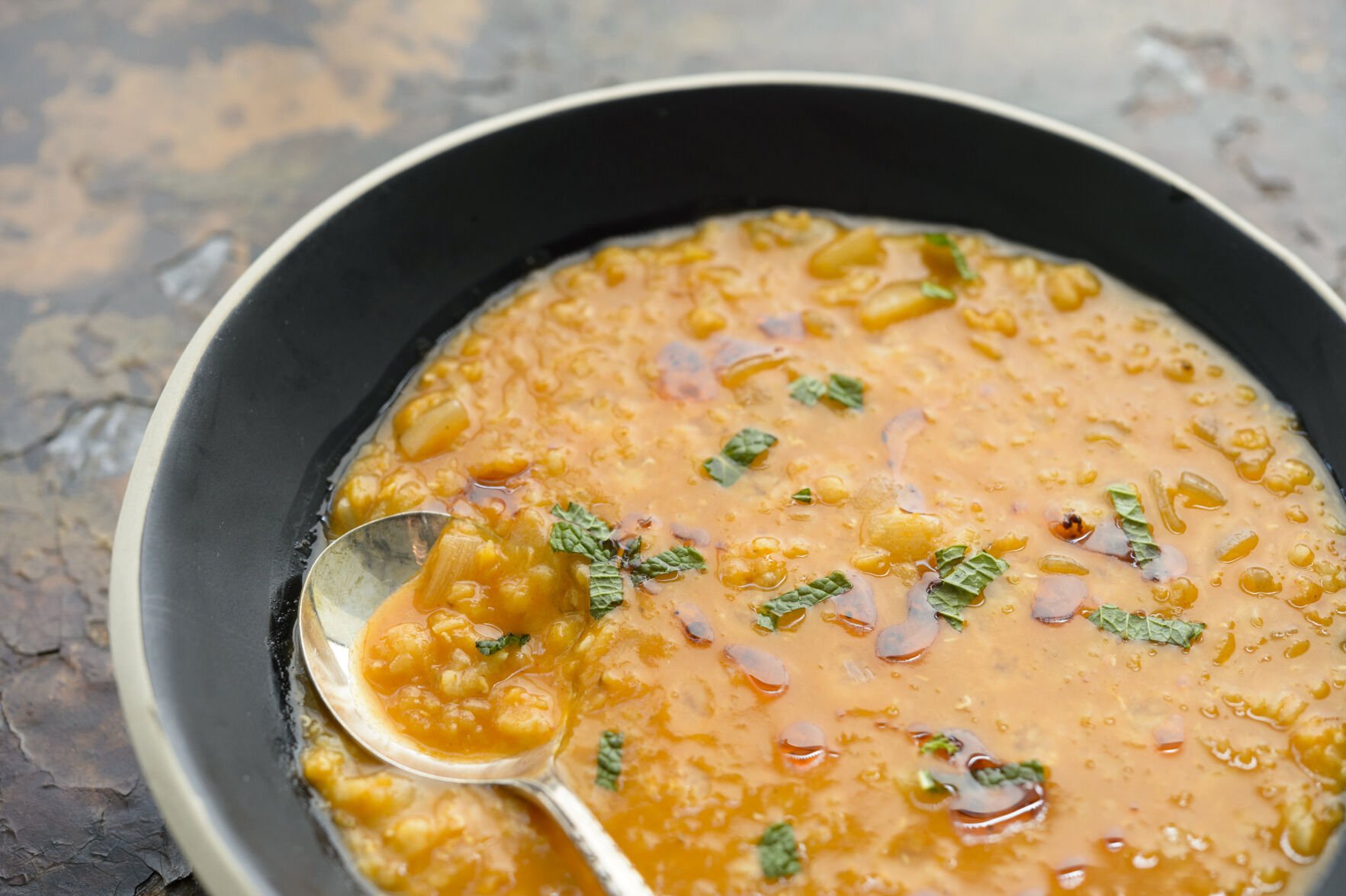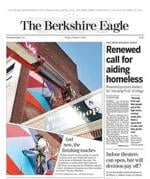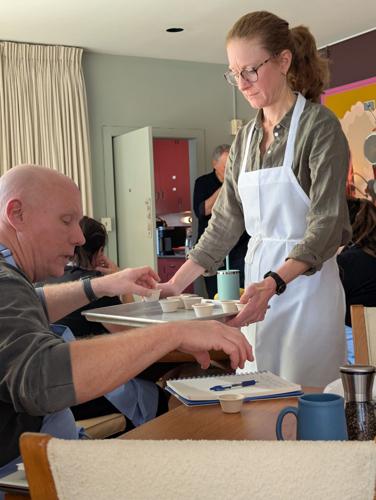
Milk Street Recipe Bootcamp participants, from left to right, Erica, Mindy and Bruce, make omelettes at the beginning of the two-day intensive workshop held in the Guest House at Field Farm in Williamstown. The omelette assignment was an exercise in using a poorly-written recipe.
"Remember, this is not a competition. We're all here to learn."
Rosemary Gill, director of education for Christopher Kimball's Milk Street, offers the reminder as four teams of two make their way to the kitchen in the Guest House at Field Farm in Williamstown, where they'll spend the next two days perfecting a single recipe. But before the teams start crafting their recipes, they are getting to know each other and their instructors by preparing an omelette. The ingredients list — butter, white wine, grainy mustard, thick bread, eight eggs, chives, kosher salt and pepper, Gruyere cheese — and directions are sparse. The outcomes are varied. One team has split the mixture and made two omelettes. Another has scrambled the eggs before adding the cheese. One team has grated the cheese, another added it in as small cubes.

"This was an exercise in following a poorly written recipe," Gill says as the teams, back in the dining area, compare the pared down recipe to the full recipe. "This is a recipe development bootcamp. That [type of] recipe is what we're trying to avoid this weekend. So, what you have here is what Milk Street believes is a properly written recipe with more prompts: How high is the heat? How long do you cook something for? ... You all more or less made the same thing. But, as you can imagine, if you are a recipe developer, you want them all to come out the same. This is not user error, this is developer error and that is what we work very hard at Milk Street to avoid."
The weekend workshop was part of a Recipe Development Bootcamp, a four-class offering (two in-person and two over Zoom) of Milk Street's In-Person Cooking School, held at the end of January. (I received an invite from Milk Street to observe the first day of the workshop, the first they've done on location.) The participants reasons for being there are as diverse as the individuals themselves. Erica and Mindy, a pair of high school culinary teachers, hope to gain insight into teaching recipe writing to their students. Bruce, a retired fireman from Maryland, loves to cook.
Nannette tells me she's joined the class to be able to pass down family recipes. "I'm Cajun. I grew up cooking with my grandmother and mother," she says. "I want to make sure the recipes taste like just like theirs."
No matter the reason for attending, they're all there for the in-person instruction from Gill and Milk Street Kitchen Director Wes Martin, who will not only offer instruction and insight, but later, one-on-one recipe development mentoring and critique.

Milk Street Director of Education Rosemary Gill hands out samples of two soup bases, each prepared slightly differently.
Milk Street, Gill says, follows four elements of recipe design: The Why (origin story); The How (selection and treatment of ingredients); The Wow (final touches) and recipe writing. The most important principle of putting together a meal, we learn, is contrast.
"Your meal should not be the same texture or flavor throughout," Gill says. "It needs some sort of diversity of texture and flavor and sensation of flavor — warming, cooling, spicy."
If making a roasted chicken, she said, it's savory, rich, greasy, tender and crispy. Following Milk Street's philosophy, accompanying dishes should include something simple, bright, refreshing and crispy. "One thing I want you to get comfortable with this weekend is talking about your ingredients as adjectives."
Next, the teams were given the assignment of creating a weeknight-friendly hearty vegetarian bean-based soup. The soup could not have more than 10 ingredients, had to use one pot, take no longer than 45 minutes from start to finish and have at least one bean/lentil and three vegetables in it. At the end of the 45 minutes, the soups presented included one inspired by a Syrian Jewish Shabbat dinner that replaced the traditional meatballs with chickpeas; a red lentil curry; a vegetarian pozole and one inspired by a Portuguese lentil dish.
"What could you remove from this dish?" Gill asked one group.
"Could you streamline the process? What if you minced all the vegetables?" Martin asked another group.

Recipe Bootcamp participants work on crafting a recipe for a vegetarian weeknight hearty-bean soup using only 10 ingredients. Some were using "Milk Street 365" for inspiration.
Suggestions from the group ranged from adding lime to changing from red to brown lentils to give the soup a "meatier flavor."
One of my favorite soups from the bootcamp drew inspiration from several red lentil dishes, including the Turkish Red Lentil Soup in "Milk Street 365," which was included in the participants' swag bags. (This cookbook has 600 recipes in it and includes comprehensive how-to guides.) Bruce and Nannette used it as a base for their soup, which would also include carrot, onion and jalapeño, fire-roasted tomatoes, a coconut milk broth base, cilantro and lime. I'm sad that I didn't get to taste their final product, but I do love to make this really easy Turkish Red Lentil Soup, which tastes even better the next day.
TURKISH RED LENTIL SOUP

I love making this Turkish Red Lentil Soup from "Milk Street 365." Not only is it easy to make, it's also packed with flavor. Photo used with permission of Voracious, an imprint of Little, Brown and Company. New York, NY. All rights reserved.
(Excerpted from "Milk Street 365" by Christopher Kimball. Copyright © 2024 by CPK Media, LLC. Used with permission of Voracious, an imprint of Little, Brown and Company. New York, NY. All rights reserved.)
Start to finish: 45 minutes
Servings: 4
Kırmızı mercİmek çorbası is a traditional Turkish soup made with red lentils, which soften and break down during cooking, adding a rustic texture that’s creamy but not starchy or heavy. Some versions include vegetables such as potatoes, carrots or fresh tomatoes, but ours lets the lentils take the lead. The Aleppo pepper brings gentle heat to the dish. If you can't find it, order online or substitute with an additional teaspoon of paprika and 1/2 teaspoon red pepper flakes. The soup can be made vegan by substituting olive oil for the butter. Don’t omit the rice. The grains help thicken the soup.
—Jeanne Maguire, Milk Street recipe developer
INGREDIENTS
3 tablespoons salted butter
1 medium yellow onion cut into 1/2-inch dice (about 1 cup)
1 medium garlic clove, finely grated
1 tablespoon tomato paste
1 tablespoon sweet paprika
1/2 teaspoon ground cumin
1 cup red lentils
2 tablespoons long-grain white rice
Kosher salt
3 tablespoons extra-virgin olive oil
2 teaspoons Aleppo pepper (see headnote)
Chopped fresh mint, to serve (optional)
Lemon wedges, to serve
DIRECTIONS
In a large saucepan over medium, melt the butter. Add the onion and cook, stirring occasionally, until softened and translucent, about 5 minutes. Add the garlic and cook until fragrant, about 30 seconds. Stir in the tomato paste, paprika and cumin, then cook for about 1 minute.
Add the lentils, rice, 5 cups of water and 1 teaspoon salt. Stir to combine then bring to a boil over medium-high. Reduce the heat to maintain a lively simmer, cover and cook, stirring occasionally, until the lentils and rice are tender and broken down, about 30 minutes. Season to taste.
Meanwhile, in a small skillet over medium, heat the oil, swirling to coat the pan. Add the Aleppo pepper and cook until a few bubbles appear and the oil is bright red. Remove from heat and set aside.
Serve the soup with Aleppo pepper oil drizzled over each serving. Serve with mint, if using, and lemon wedges on the side.
READ IT
"Milk Street 365" by Christopher Kimball
Published by Voracious, an imprint of Little, Brown and Company
640 pages
$45
TAKE A CLASS
Interested in taking one of Milk Street's classes?
Milk Street offers online classes and in-person classes at Milk Street's school in Boston.
Online classes are available via livestream or as a self-paced pre-recorded lesson. To learn more, visit 177milkstreet.com/school/classes/online-classes.
In-person classes run about 2 1/2 hours at 177 Milk St. in Boston. For a list of upcoming classes, visit 177milkstreet.com/school/classes/boston-school.







